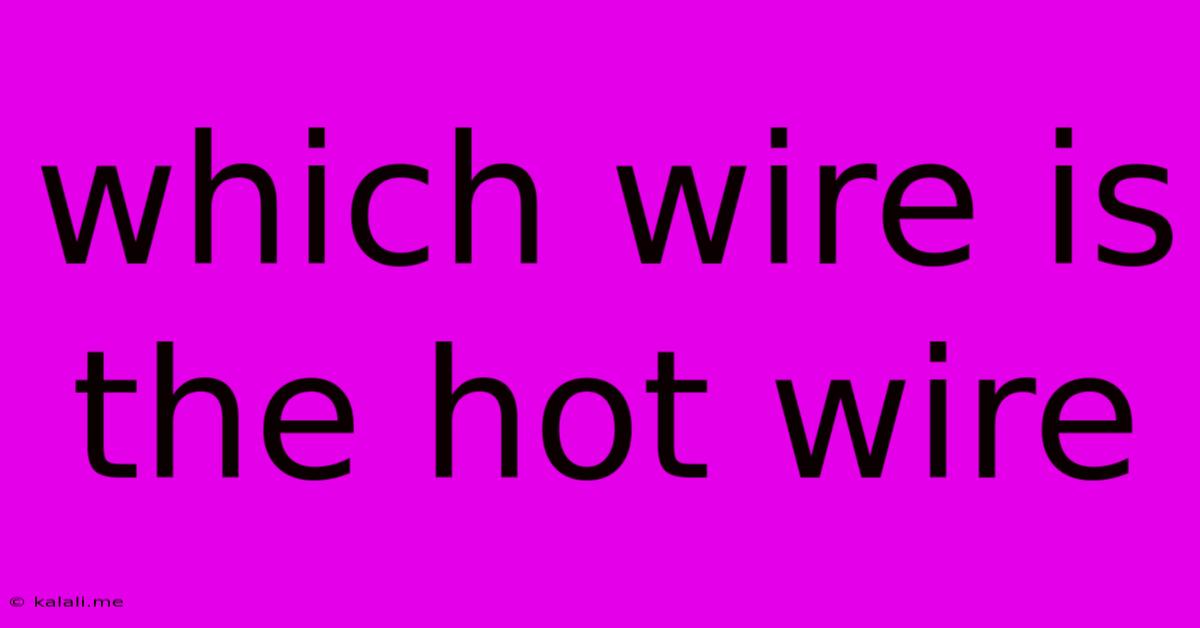Which Wire Is The Hot Wire
Kalali
May 31, 2025 · 3 min read

Table of Contents
Identifying the Hot Wire: A Comprehensive Guide for Homeowners
Meta Description: Unsure which wire is the hot wire in your home's electrical system? This guide provides a clear explanation of hot wires, how to identify them safely, and crucial safety precautions. Learn to distinguish hot wires from neutral and ground wires.
Identifying the hot wire in your home's electrical system is crucial for any DIY electrical work, repairs, or even just understanding your home's wiring. Incorrectly identifying the hot wire can lead to serious injury or even death from electric shock. This guide will teach you how to safely identify hot wires, emphasizing the importance of safety throughout the process. Remember, if you're uncomfortable working with electricity, always consult a qualified electrician.
What is a Hot Wire?
A hot wire, also known as a live wire, carries the electrical current from your power source (e.g., the electrical panel) to your electrical devices. It's the wire that provides the power needed for lights, appliances, and outlets to function. The voltage of a hot wire varies depending on the circuit; in most homes in North America, it's 120 volts for standard circuits and 240 volts for larger appliances like ovens and dryers.
Identifying Hot Wires: Safety First!
Before attempting to identify any wires, always turn off the power to the circuit you're working on at the breaker box. This is the most crucial safety step. Never rely on just turning off a light switch or appliance; always cut power at the source.
After turning off the power, you can use the following methods to help you identify hot wires:
-
Visual Inspection (with caution): In some cases, hot wires may be identified by their color coding. In North America, hot wires are typically black, red, or blue. However, this is not a reliable method and should only be used as a very preliminary check, and never as the sole method of identification. Older wiring may not follow these color codes, and mistakes can be fatal.
-
Voltage Testing: Using a non-contact voltage tester (NCVT) is the safest and most reliable way to identify hot wires. A NCVT will detect the presence of voltage without requiring direct contact with the wire. If the tester lights up or beeps when held near a wire, it indicates a live hot wire. Always use a reputable and properly functioning NCVT. Note that even with the power off at the breaker, there's a slight chance of residual voltage, so a non-contact tester is your best bet.
-
Using a Multimeter: A multimeter is a more advanced tool that provides more information about voltage and current. While providing more information, this tool requires direct contact with the wire. Hence, its use should only be undertaken by individuals who have experience and are familiar with this testing procedure. It should never be used as the primary way to identify the hot wire.
Other Wires: Neutral and Ground
Understanding the differences between hot wires and other wires is equally important:
-
Neutral Wire: This wire completes the electrical circuit and carries the current back to the power source. In North America, it's usually white or grey.
-
Ground Wire: This wire provides a path for fault currents to safely flow back to the ground, preventing electric shock. It's typically bare copper or green.
Essential Safety Precautions:
- Always turn off the power at the breaker box before working with any wires. This is non-negotiable.
- Use appropriate safety equipment, including insulated tools and safety glasses.
- Never work alone. Have someone else present in case of an emergency.
- If you are unsure about anything, call a qualified electrician. Electricity is dangerous, and mistakes can have severe consequences.
This guide provides a basic understanding of identifying hot wires. Remember that working with electricity can be dangerous. If you're not comfortable performing these tasks, always seek the help of a qualified electrician. Your safety is paramount.
Latest Posts
Latest Posts
-
2 Stroke Gas In 4 Stroke
Jun 01, 2025
-
Google Sheets Check If Cell Contains String
Jun 01, 2025
-
Is Faith A Gift From God
Jun 01, 2025
-
No Home Directory For User Linux
Jun 01, 2025
-
How To Find Equation Of Exponential Graph With Two Points
Jun 01, 2025
Related Post
Thank you for visiting our website which covers about Which Wire Is The Hot Wire . We hope the information provided has been useful to you. Feel free to contact us if you have any questions or need further assistance. See you next time and don't miss to bookmark.